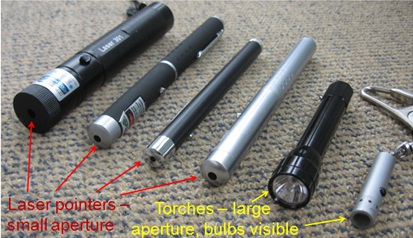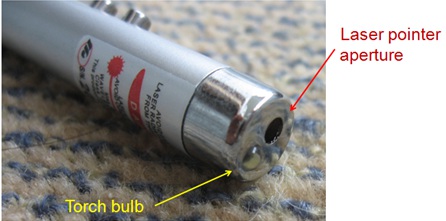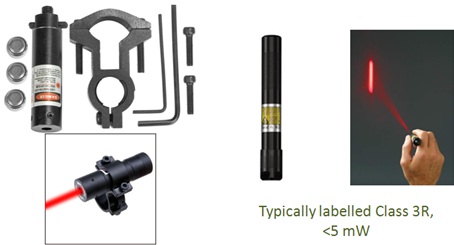Control of high-power laser pointers
Table of Contents
Table of Contents
2
Policy statement and principles
3
What
3
Why
3
How
3
Overview
4
What uses do laser pointers have?
4
What is a high‐power laser pointer?
4
Mean ng of ow d vergence
4
How powerful are laser pointers?
4
Controls on high‐power laser pointers
5
Restrictions on sale and supply
5
Import restrictions
5
Laser devices exempted or not considered high‐power
5
Police are authorised suppliers or recipients
5
Offences
6
Summary Offences Act 1981
6
Health (High‐power Laser Pointers) Regulations 2013
6
Customs and Excise Act 2018
6
Civil Aviation Act 1990
6
Crimes Act 1961
6
Other
6
Guidance for specific offences
8
Offences against aircraft
8
Identifying high‐powered laser pointers
9
How can you tell if a device is a high‐power laser pointer?
9
Laser light characteristics
9
Typical labels
9
Laser pointers and torches
10
Surveying and measuring devices (exempt)
10
Hunting devices and laser flares (exempt)
10
If in doubt, contact the Ministry of Health
11
Control of high-power laser pointers
Policy statement and principles
What
Laser pointers are a type of laser, with laser meaning ‘Light Amplification by Stimulated Emission of Radiation’. Laser pointers emit a
tightly focused beam of light that can be concentrated onto a very small area over long distances. While the power in the beam may be
only a few milliwatts, the concentration of this power onto a small area creates a point of very high intensity.
Lower‐power laser pointers have been sold unrestricted for many years in New Zealand, but more powerful laser pointers have now
become available at relatively low cost, often via the internet. Purchase of these from overseas suppliers via the internet is not difficult,
and importation into the country will likely only be noticed by Customs if the labelling of the product on declaration certificates is
accurate.
Why
There have been incidents of laser beams directed into the cabins of moving motor vehicles and the cockpits of flying aircraft. This
reckless practice can blind drivers and pilots and endangers life.
How
‑ The supply of, and receipt of high‐power laser pointers is controlled by the Health (High‐power Laser Pointers) Regulations 2013
, and is limited to authorised suppliers and recipients.
‑ The Customs Import Prohibition (High‐power Laser Pointers) Order 2019 prohibits the importation of high‐power laser pointers
except with the consent of the Director‐General of Health.
‑ Purchase of high‐power laser pointers from overseas suppliers over the internet is not difficult, therefore, there is a high risk of
these devices being available in the community.
‑ It is an offence against 13(b) of the Summary Offences Act 1981 for anyone, in a public place, to be in possession of a high‐power
laser pointer without reasonable excuse.
‑ High‐power laser pointers can generally be identified by description labels found on the device. Lasers used for surveying,
measuring or hunting are generally exempt from regulations.
3/11
Control of high-power laser pointers
Overview
What uses do laser pointers have?
Laser pointers are often used as presentation aids by lecturers and teachers and are also used for recreational purposes ‐ to shine onto
objects. The lower‐power laser pointers are sufficient for such purposes. The higher‐power ones can be shone into the night sky and
are used by astronomers. Some researchers or scientists may also use them.
What is a high‐power laser pointer?
The Health (High‐power Laser Pointers) Regulations 2013, the Customs Import Prohibition (High‐power Laser Pointers) Order 2019,
and the Summary Offences Act 1981 define a
high‐power laser pointer as a device that:
‑ in the Director‐General of Health's opinion, is of the kind commonly known as a laser pointer; and
‑ is battery operated; and
‑ is designed or intended to be operated while held in the hand; and
‑ produces a coherent beam of optical radiation of low divergence; and
‑ has a power output
of greater than 1 milliwatt (mW).
Meaning of low divergence
In this context, low divergence means a beam that does not fan out like, for example, a torch beam.
How powerful are laser pointers?
Laser pointers come in a range of power outputs. The power output is usually measured in milliwatts. As a guide, the relationship
between power and potential harm of the different types of laser pointer is shown in this table.
Laser pointer output power
Health risk posed
Up to and including 1 milliwatt Low‐risk
Greater than 1 and up to 5
Relatively low‐risk, but could still potentially cause some harm to the eye (e.g., if shone into eyes
milliwatts
from a short distance)
Greater than 5 and up to 500
Risk of eye damage
milliwatts
Greater than 500 milliwatts
Can burn skin and damage eyes
There are schemes which classify laser pointers according to the risks they pose. The classification may use Arabic numerals (1, 2, 3, 4 ‐
with or without a letter after the number) or Roman numerals (I, II, III, IV ‐ with or without a letter after the number). Laser pointers of
Class 1, 2, I, II or IIA have a power up to and including 1 milliwatt and so would not be covered by the Health or Customs Regulations.
At a glance most people will not be able to tell the difference between a low‐power laser pointer and a riskier high‐power pointer.
While some devices have their power outputs written on them, most people cannot readily translate such inscriptions (e.g., '5 mW')
into the potential for harm to be caused by such a device.
4/11
Control of high-power laser pointers
Controls on high‐power laser pointers
Restrictions on sale and supply
The Health (High‐power Laser Pointers) Regulations 2013 restrict the sale/supply of high‐power laser pointers to those who are
'authorised suppliers'. The regulations also restrict the acquisition of such devices to those who are 'authorised recipients'. The
Director‐General of Health may authorise (upon application) a person or class of person to supply or acquire high power laser pointers.
Offences against these regulations include:
‑ Supply by a non‐authorised supplier
‑ Supply to an non‐authorised recipient
‑ Acquisition using misleading or deceitful means.
The Director‐General of Health is the only person who can authorise suppliers/recipients and
Police have no specific search and
seizure powers under the regulations.
Import restrictions
The Customs Import Prohibition (High‐power Laser Pointers) Order 2019 prohibits the importation of high‐power laser pointers,
except with the
consent of the Director‐General of Health.
See PDF below: Police authority to import
‑
Approva o impor aser poin ers March 2020
101.75 KB
Laser devices exempted or not considered high‐power
The regulations do not apply to:
‑ specialist equipment for use in construction or surveying
‑ equipment used to measure distances
‑ equipment supplied with fixtures for mounting on a firearm (as a sighting aid)
‑ devices intended for use as a rescue flare.
No consent needed
Consent required
‑ Power ≤1 mW
‑ Power greater than 1 mW
‑ Class 1x, 2x, Ix, Class IIx (x any letter)
‑ Class 3x, Class 4, Class IIIx, Class IV (x any letter)
‑ Laser used in surveying, construction or distance measurement
‑ Device supplied with attachments for mounting on rifle
‑ Rescue flare
Police are authorised suppliers or recipients
The Director‐General of Health has
declared "the New Zealand Police and all Police employees (as defined in the Policing Act 2008)
acting in the course of their duties" to be authorised suppliers or authorised recipients.
See the Supply, acquire and import of high‐power laser pointers delegation.
5/11
Control of high-power laser pointers
Offences
Summary Offences Act 1981
Under section 13B of the Summary Offences Act 1981 anyone who, in any public place, without reasonable excuse, has any high‐power
laser pointer in their possession commits an offence. If convicted, the penalty is imprisonment for a term not exceeding 3 months or a
fine not exceeding $2,000. In addition the court may order that the high‐power laser pointer be forfeited to the Crown.
Where this offence has been committed, Police may seize the high‐power laser pointer pursuant to arrest or while conducting a lawful
search power (see sections 88 and 123 of the Search and Surveillance Act 2012).
For any prosecution where there is a dispute about whether the device is a high‐power laser pointer, the following steps may need to
be taken.
StepAction
1
A picture along with information about the laser pointer will need to be sent to the Ministry of Health
([email address]). The Director‐General of Health (or delegate) will advise by letter whether the laser pointer "is of a
kind commonly known as a laser pointer".
2
The laser pointer will need to be tested to confirm whether it meets the requirements of section 13B(3)(b) ‐ (e).
Health (High‐power Laser Pointers) Regulations 2013
Offences include:
‑ supplying such devices to non‐authorised suppliers or recipients (regulations 4 and 5)
‑ acquiring such devices using misleading or deceitful means (regulation 6)
‑ authorised suppliers who acquire high‐power laser pointers for any purpose other than supply (unless they are also an
authorised recipient) (regulation 7).
A person who commits an offence against the regulations is liable upon conviction to a maximum penalty of $500 under section 136 of
the Health Act 1956. There are no specific powers of seizure. The Ministry of Health has primary responsibility for investigations and
prosecutions against the regulations.
Customs and Excise Act 2018
Section 388(1)(a) of the Customs and Excise Act 2018 provides for the offence of importing prohibited goods. If convicted, an individual
is liable to a fine not exceeding $5,000. A body corporate is liable on conviction to a fine not exceeding $25,000.
Civil Aviation Act 1990
Where a high‐powered laser is shone at an aircraft that is in the air, or in the process of taking off or landing, there is the provision for
an offence in the Civil Aviation Act. Under section 44 of the Civil Aviation Act 1990, any person who does any act in respect of an aircraft
in a manner which causes unnecessary danger to any other person or property is liable on conviction to a term of imprisonment of 12
months or a fine not exceeding $10,000.
Crimes Act 1961
Similarly, where a high‐powered laser is shone at an aircraft that is in the air, or in the process of taking off or landing, there is the
provision for an offence in the Crimes Act where the offending or is more serious. Under section 270 of the Crimes Act 1961, everyone is
liable for a term not exceeding 14 years who with intent to cause danger to persons or property, or with reckless disregard for the safety
of persons or property, interferes with any transport facility or does anything to any transport facility that is likely to cause danger to
persons or property. Under section 270(2), transport facility includes an aircraft and equipment of any kind used in navigation or for the
guidance of an aircraft.
Other
Other offences may be committed through improper use of a laser. Such offences could include:
6/11
Control of high-power laser pointers
‑ Assault if a laser is deliberately shone in someone's eyes or at their body (see Graves v Police (HC Rotorua, Lang J, 12/12/10, CRI‐
2010‐463‐57).
‑ Acts endangering public safety if shone at drivers.
7/11
Control of high-power laser pointers
Guidance for specific offences
Offences against aircraft
High‐powered lasers aimed at aircraft is a regular occurrence. Where it is shone into the cockpit it can potentially cause “flash
blindness” or temporary blindness to the pilot. This can last for up to three minutes and presents a serious risk to the safety of the
aircraft. Typically, these incidents will occur at airports as aircraft are landing or taking off. Where a laser has been aimed at an aircraft,
the pilot will notify air traffic control who will then notify Police.
For further assistance or guidance on incidents involving laser strikes on aircraft, the Civil Aviation Authority (CAA) is available. Their
contact details are:
‑ Phone: 0508 4SAFETY (0508 472338) ‐ a voicemail can be left after hours
‑ E‐mail: [email address]
‑ Website: https://www.aviation.govt.nz/
8/11


Control of high-power laser pointers
Identifying high‐powered laser pointers
How can you tell if a device is a high‐power laser pointer?
The Ministry of Health has developed a flow chart to provide some practical guidance to help identify whether or not a device is a high‐
power laser pointer covered by the new controls:
‑
Laser poin er diagram (MoH).pd
937.27 KB
Laser light characteristics
‑ Single colour (e.g., red, blue, green).
‑ Fine beam, low divergence (i.e., doesn't spread or fan out, like a torch).
‑ Laser speckle when shine on matt surface.
Typical labels
You can also identify these devices by checking their labels.
However, labels are small and can be hard to read, as shown in this diagram.
If a device has no labelling, look at the power source:
If . . .
then . . .
and . . .
only one button battery
assume less than 1 mW
the device is exempt.
two or more button batteries, or AAA assume greater than 1mW, import consent
the person in possession must prove they are
or bigger, or external battery
needed
an authorised supplier or recipient.
still in doubt
the person in possession must prove they are
an authorised supplier or recipient.
9/11



Control of high-power laser pointers
Laser pointers and torches
Laser pointers and torches can look very similar as shown in this diagram.
This diagram shows a hybrid laser pointer/torch device.
Surveying and measuring devices (exempt)
This diagram shows some typical surveying or measuring devices which are exempt.
Hunting devices and laser flares (exempt)
This diagram shows some typical hunting devices and laser flares which are exempt.
10/11

Control of high-power laser pointers
If in doubt, contact the Ministry of Health
If you are still unsure, you can email the Ministry of Health at [email address]. Provide your contact details and a
description of the device (and a photo, if possible). Provide as much information about the device as you can. For example, its output
power, a link to the manufacturer's or supplier's website, any labelling or documentation provided with the device, etc.
For more information see the Ministry of Health information website.
11/11





